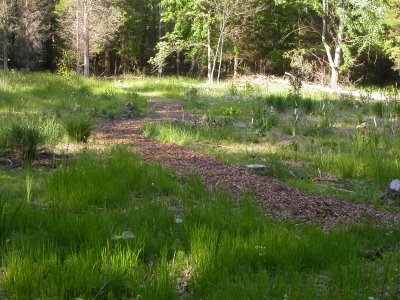Imagining the landscape

The future garden is a flat, rather featureless space, especially viewed from the house, which is situated on a raised mound about 15 feet above the surrounding land. Now that we're opening up the space - and the view - by taking down trees, the flatness of the land is more evident, even though there is a gentle, barely perceptible slope, moving away from the house, toward Lokatong Creek at the bottom of the hill.
I'd already been aware of the need to divide the space with screening (small trees, shrubs, large perennials) and to create spatial diversity, interest, and a sense of scale. Last weekend, we started laying out the secondary path of cedar chips through the middle of the space. (The main path will circle around from one end of the house, to the back of the garden, then back to the opposite end of the house. It will be twice as wide as the secondary path, at about seven feet.)
We got the cedar chips about half way across the field, then I cut the rest of the path with a string trimmer. Even in this unfinished state, the secondary path has reorganized my perception of the space, making clear where various plant communities, shapes, and forms might be used to make the new garden. Like a line on a blank canvas, the path suggests its own landscape, drawing the eye to previously unseen features, small surface undulations, rocks, native rushes, carexes, and equisetum.
Barely visible yet, a garden is coming into view.
James Golden